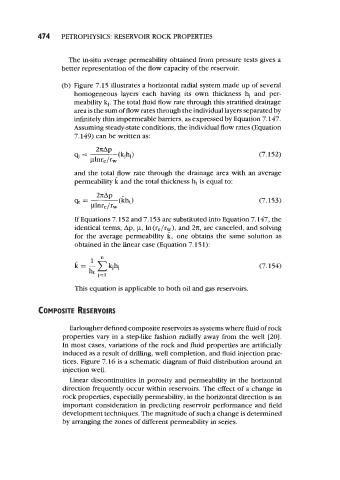Page 506 - Petrophysics
P. 506
474 PETROPHYSICS: RESERVOIR ROCK PROPERTIES
The in-situ average permeability obtained from pressure tests gives a
better representation of the flow capacity of the reservoir.
(b) Figure 7.15 illustrates a horizontal radial system made up of several
homogeneous layers each having its own thickness h, and per-
meability ki . The total fluid flow rate through this stratified drainage
area is the sum of flow rates through the individual layers separated by
infinitely thin impermeable barriers, as expressed by Equation 7.147.
Assuming steady-state conditions, the individual flow rates (Equation
7.149) can be written as:
(7.152)
and the total flow rate through the drainage area with an average
permeability k and the total thickness ht is equal to:
(7.153)
If Equations 7.152 and 7.153 are substituted into Equation 7.147, the
identical terms, Ap, p, ln(re/r,), and 271, are canceled, and solving
for the average permeability k, one obtains the same solution as
obtained in the linear case (Equation 7.151):
1 n
k = - Ckjhj (7.154)
ht j=1
This equation is applicable to both oil and gas reservoirs.
COMPOSITE RESERVOIRS
Earlougher defined composite reservoirs as systems where fluid of rock
properties vary in a step-like fashion radially away from the well [20].
In most cases, variations of the rock and fluid properties are artificially
induced as a result of drilling, well completion, and fluid injection prac-
tices. Figure 7.16 is a schematic diagram of fluid distribution around an
injection well.
Linear discontinuities in porosity and permeability in the horizontal
direction frequently occur within reservoirs. The effect of a change in
rock properties, especially permeability, in the horizontal direction is an
important consideration in predicting reservoir performance and field
development techniques. The magnitude of such a change is determined
by arranging the zones of different permeability in series.

